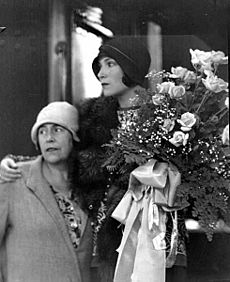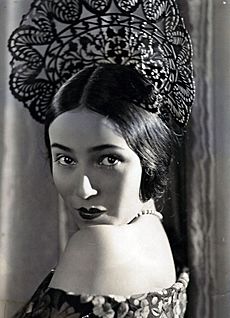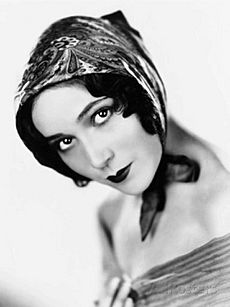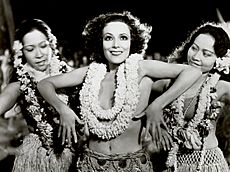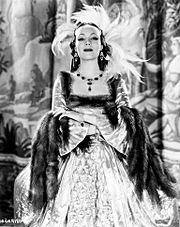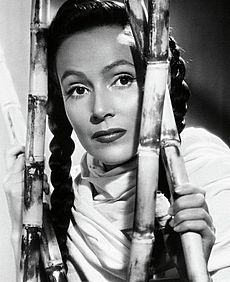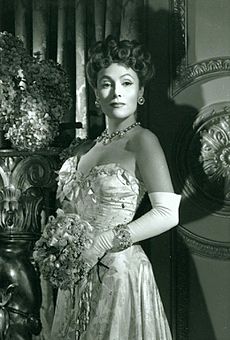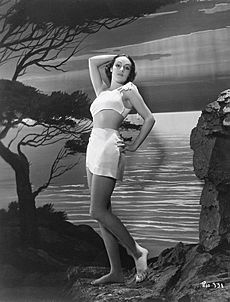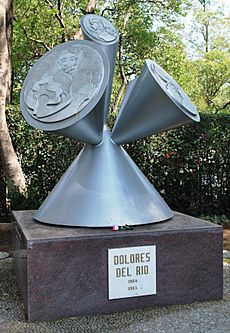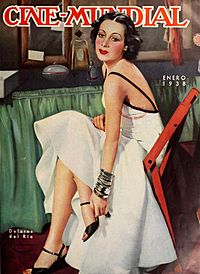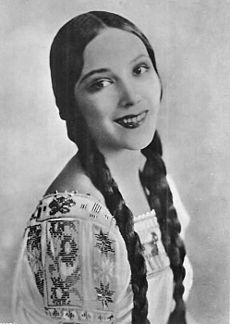Dolores del Río facts for kids
Quick facts for kids
Dolores del Río
|
|
|---|---|
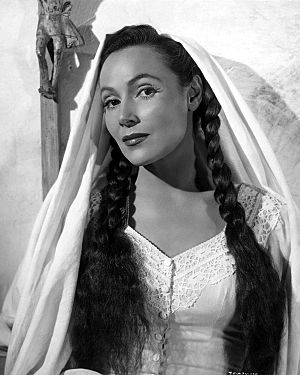
Dolores del Río in The Fugitive (1947)
|
|
| Born |
María de los Dolores Asúnsolo y López Negrete
3 August 1904 Victoria de Durango, Durango, Mexico
|
| Died | 11 April 1983 (aged 78) Newport Beach, California, U.S.
|
| Resting place | Rotonda de las Personas Ilustres, Panteón de Dolores, Mexico City, Mexico |
| Occupation | Actress |
| Years active | 1925–1978 |
| Spouse(s) |
Jaime Martínez del Río
(m. 1921; div. 1928)Lewis A. Riley
(m. 1959) |
| Relatives |
|
| Signature | |
 |
|
María de los Dolores Asúnsolo y López Negrete (born August 3, 1904 – died April 11, 1983), known as Dolores del Río, was a famous Mexican actress. She had a career that lasted over 50 years. Many people see her as the first big female star from Latin America to become famous in Hollywood. She had a great career in American movies in the 1920s and 1930s. She was also a very important actress during the Golden Age of Mexican cinema and was known as one of the most beautiful actresses of her time.
Dolores del Río was discovered in Mexico and started her film career in Hollywood in 1925. She starred in many successful silent films like Resurrection (1927), Ramona (1928), and Evangeline (1929). During the silent movie era in America, she was seen as a female version of the famous actor Rudolph Valentino.
When movies started having sound, she acted in many different types of films. These included crime stories, musicals, and romantic dramas. Some of her most popular movies from that time were Bird of Paradise (1932), Flying Down to Rio (1933), and Madame Du Barry (1934). In the early 1940s, her Hollywood career slowed down. Dolores del Río then went back to Mexico and joined the Mexican film industry, which was very popular at that time.
When she returned to Mexico, she became one of the biggest stars of the Golden Age of Mexican cinema. Many of her Mexican films are now considered classic masterpieces. They helped make Mexican cinema famous around the world. One of her most praised films was María Candelaria (1943). Dolores del Río continued to act mainly in Mexican films throughout the 1950s. In 1960, she returned to Hollywood. For the next few years, she appeared in both Mexican and American movies. From the late 1950s to the early 1970s, she also had a successful career in theater in Mexico and appeared in some American TV shows.
Dolores del Río is often seen as a perfect example of Mexican women in the world.
Life and career
1904–1925: Early life and first marriage
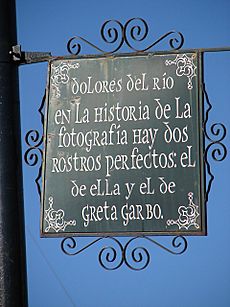
María de los Dolores Asúnsolo y López Negrete was born in Victoria de Durango, Mexico, on August 3, 1904. Her father, Jesús Leonardo Asúnsolo Jacques, was from a wealthy farming family and managed the Bank of Durango. Her mother, Antonia López Negrete, came from one of the richest families in Mexico, with roots going back to Spanish nobility.
Her parents were part of the Mexican upper class during the time when Porfirio Díaz was president. On her mother's side, she was a cousin to filmmaker Julio Bracho and actors Ramón Novarro and Andrea Palma. On her father's side, she was a cousin to sculptor Ignacio Asúnsolo. She was also the aunt of actress Diana Bracho.
Dolores's family lost all their money during the Mexican Revolution (1910-1920). Wealthy families in Durango were in danger because of the revolution led by Pancho Villa. The Asúnsolo family decided to escape. Her father went to the United States, and Dolores and her mother went to Mexico City by train, dressed as peasants. In 1912, the family reunited in Mexico City and were protected by the president at the time, Francisco I. Madero, who was Antonia's cousin.
Dolores went to the Collège Français de Saint-Joseph, a school run by French nuns in Mexico City. She loved to dance. This passion started when her mother took her to a performance by the Russian dancer Ana Pavlova. She later saw performances by Antonia Mercé "La Argentina" and decided to become a dancer herself. She convinced her mother to let her take dance lessons. However, Dolores felt very insecure and thought she was "ugly." Her mother asked the famous painter Alfredo Ramos Martínez to paint her daughter's portrait. This portrait helped Dolores feel better about herself.
In 1921, at age 17, Dolores was invited to dance at a party to help a local hospital. There, she met Jaime Martínez del Río y Viñent, who came from a wealthy family. Jaime had studied in England and spent time in Europe. After two months, they married on April 11, 1921. She got her famous last name from him.
Their honeymoon lasted two years, and they traveled through Europe. In Spain, Dolores danced for the Spanish kings (Alfonso XIII and Victoria Eugenie). They were impressed and the queen gave her a photograph. When they returned to Mexico, Jaime decided to grow cotton. But in 1924, the price of cotton dropped, causing them financial problems. They had to move to Mexico City and rely on their families for money. Dolores had to sell her jewelry to help. She also had a difficult pregnancy that ended in a miscarriage, and doctors advised her not to have children again.
1925–1929: Silent films
In early 1925, the painter Adolfo Best Maugard, a friend of Dolores and Jaime, visited their home with American filmmaker Edwin Carewe. Carewe was a director at First National Pictures and was in Mexico for a wedding. He was very impressed by Dolores and wanted her to work in Hollywood. He convinced Jaime by saying he could make Dolores a movie star, like a "female Rudolph Valentino." Jaime thought this could solve their money problems and help him achieve his dream of writing screenplays.
Against their families' wishes (except for Dolores's mother), they traveled by train to the United States to start a film career. They arrived in Hollywood on August 27, 1925. Carewe signed Dolores to a contract and became her agent, manager, producer, and director. Her name was shortened to "Dolores Del Rio."
She made her film debut in Joanna (1925), directed by Carewe. She played a small role for about five minutes. Carewe continued to promote her, and she got a small role in High Steppers (1926), starring Mary Astor. That same year, Carl Laemmle, head of Universal Studios, wanted Dolores for the comedy The Whole Town's Talking. These films were not huge hits, but they helped her become more known to the public. Dolores got her first main role in the comedy Pals First (1926), also directed by Carewe, but this film is now lost.
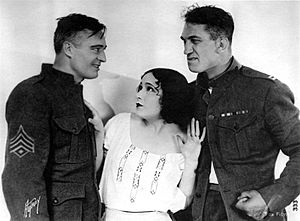
Film director Raoul Walsh cast Dolores in the war film What Price Glory? (1926). This film was a big success, earning almost $2 million in the U.S. alone. In the same year, because of her growing career, she was chosen as one of the WAMPAS Baby Stars of 1926. This group included other new stars like Joan Crawford, Mary Astor, and Janet Gaynor.
In 1927, Dolores and Carewe worked with United Artists on Resurrection, based on a novel by Leo Tolstoy. Dolores played the heroine. Because of the film's success, Fox Film quickly made The Loves of Carmen with Dolores and Victor McLaglen, also directed by Raoul Walsh. Fox Film also cast her in No Other Woman (1928).
When actress Renée Adorée became ill, Dolores was chosen for the main role in the MGM film The Trail of '98, directed by Clarence Brown. The film was a huge success and received good reviews. Also in 1928, she was hired by United Artists again for the third film version of the novel Ramona, directed by Carewe. The film's success was helped by the song "Ramona," which Dolores recorded. Ramona was the first United Artists film with synchronized sound.
In late 1928, Hollywood was preparing for sound films. On March 29, at Mary Pickford's home, United Artists gathered stars like Pickford, Dolores, Douglas Fairbanks, Charles Chaplin, and others to speak on a radio show. This was to show they could handle talking movies. Dolores surprised everyone by singing "Ramona," proving she was ready for sound films.
While her career was doing well, her personal life was challenging. Her marriage to Jaime Martínez ended in 1928. After a short separation, Dolores filed for divorce. Six months later, she learned that Jaime had passed away in Germany. Dolores also faced difficulties with Edwin Carewe, who wanted to control her career and personal life.
Dolores made her third film with Raoul Walsh, The Red Dance (1928). Her next project was Evangeline (1929), a new United Artists film also directed by Carewe. It was based on a famous poem. The film included a theme song sung by Dolores. Like Ramona, this film was released with sound effects and music.
Edwin Carewe wanted to marry Dolores and become a famous Hollywood couple. He started a divorce from his wife and spread false rumors. But during the filming of Evangeline, United Artists advised Dolores to separate from Carewe professionally, as he still had an exclusive contract with her.
After the successful premiere of Evangeline in New York, Dolores told reporters, "Mr. Carewe and I are just friends and colleagues in cinema. I will not marry Mr. Carewe." She eventually canceled her contract with him. Carewe was angry and filed legal charges against Dolores. With advice from United Artists lawyers, Dolores settled the matter outside of court. Despite this, Carewe started a campaign against her. To overshadow her, he filmed a new sound version of Resurrection starring Lupe Vélez, another popular Mexican actress.
After finally separating from Carewe professionally, Dolores was ready for her first talkie: The Bad One, directed by George Fitzmaurice. The film was released in June 1930 and was a big success. Critics said Dolores could speak and sing in English with a charming accent, making her a good star for sound films.
1930–1936: Transition to sound films
In 1930, Dolores met Cedric Gibbons, an art director at Metro-Goldwyn-Mayer and a very important person in Hollywood, at a party. They started a relationship and married on August 6, 1930. Soon after her marriage, Dolores became very ill with a kidney infection. Doctors told her to rest for a long time, which ended her contract with United Artists. When she recovered, she was hired by RKO Pictures. Her first film with them was Girl of the Rio, released in 1931.
Producer David O. Selznick asked filmmaker King Vidor to make a love story with Dolores and Joel McCrea in the South Seas. Bird of Paradise (1932) was filmed in Hawaii, and Dolores played a beautiful native woman. The film premiered on September 13, 1932, in New York and received excellent reviews.
Since RKO was happy with the results, they quickly decided to have Dolores make another film. This was a musical comedy directed by Thornton Freeland called Flying Down to Rio (1933). In this film, Fred Astaire and Ginger Rogers first appeared as dance partners. Dolores danced with Fred Astaire in a complex number called Orchids in the Moonlight. In this movie, Dolores became the first major actress to wear a two-piece women's bathing suit on screen. But after the premiere, RKO faced financial problems and decided not to renew Dolores's contract.
Jack Warner offered her a main role in two films for Warner Bros.. The first was the musical comedy Wonder Bar (1934), directed by Lloyd Bacon. Busby Berkeley was the choreographer, and Al Jolson was her co-star. Dolores's character became more important in the film, while the role of the other female star, Kay Francis, was reduced. The film was released in March 1934 and was a success for Warners.
The second film was Madame Du Barry (also 1934), with Dolores as the star and William Dieterle as director. Dieterle focused on her beauty, with amazing costumes designed by Orry Kelly. The film was not as successful as expected, but it is still considered one of Dolores's most popular films from her Hollywood period.
In the same year, Dolores, along with Ramón Novarro and Lupe Vélez, attended a special screening of the Mexican film ¡Que viva México!. The film was accused of promoting Communism in California. This was the first time Dolores was accused of being a communist in the United States, which would later affect her career in American films.
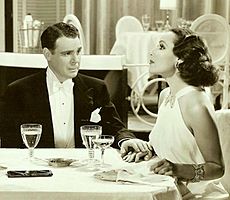
Warner Bros. hired her again in 1935 to star in another musical comedy called In Caliente (1935), where she played a Mexican dancer. Around the same time, she starred in I Live for Love (also 1935), directed by Busby Berkeley. The film featured dance numbers, and Berkeley highlighted her glamour with sophisticated costumes. Her last film with Warners was The Widow from Monte Carlo (1936), which was not very popular.
1937–1942: Career changes in Hollywood
With the support of Universal Studios, Dolores filmed The Devil's Playground (1937) with Chester Morris and Richard Dix. However, despite the popularity of the three stars, the film was not successful. Dolores decided to sign a contract with 20th Century Fox to star in two films with George Sanders. She appeared with him in Lancer Spy (1937) and International Settlement (1938). Both films did not do well at the box office. These film failures led her to focus on advertising, becoming known for ads for "Lucky Strike" cigarettes and "Max Factor" makeup.
Cedric Gibbons used his influence at Metro-Goldwyn-Mayer to get Dolores the main female role in the 1940 film The Man from Dakota. But even with his position, Gibbons could not help his wife achieve a higher profile. At that time, the main stars of MGM were Greta Garbo, Norma Shearer, Joan Crawford, and Jean Harlow. Studio executives admired Dolores's beauty, but they were not very interested in her career because Latin stars had few opportunities to shine at the studio. She was even put on a list called "box office poison" (along with stars like Joan Crawford and Greta Garbo). This list was given to Los Angeles newspapers by a movie theater owner who felt these stars' high salaries did not match their low ticket sales.
During this time, in 1940, Dolores met actor and filmmaker Orson Welles at a party. They became close. This led to Dolores's divorce from Gibbons. While looking for ways to restart her career, she joined Welles in his shows across the United States, radio work, and performances at the Mercury Theatre. Dolores was by his side during the filming and controversy of Citizen Kane (1941). This film, now considered a masterpiece, caused a scandal because it criticized media owner William Randolph Hearst, who then tried to stop Welles's projects.
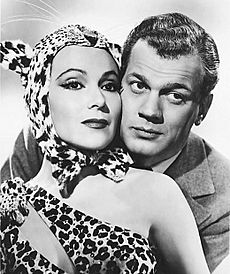
In early 1942, she began working on Journey into Fear (released in 1943) with Norman Foster as director and Welles as producer. Her connection with Welles, during the Citizen Kane scandal, affected her role in the film, which was greatly reduced. Nelson Rockefeller, who was in charge of the Good Neighbor policy (and also connected to RKO through his family's investments), hired Welles to visit South America as a goodwill ambassador. Welles left the film four days later and traveled to Rio de Janeiro. Dolores decided to end her relationship with Welles. Weeks later, her father passed away in Mexico.
1943–1959: Mexican Cinema
Mexican film directors had wanted Dolores del Río for their films since the late 1930s. She was considered for Mexican films like La Noche de los Mayas and Santa. For Santa, Orson Welles even helped with the script. But the financial situation was not right for Dolores to join Mexican cinema. She also had good relationships with Mexican artists and cultural figures like Diego Rivera and Frida Kahlo. After her relationship with Welles ended, Dolores del Río returned to Mexico.
As soon as she returned, Dolores started getting movie offers. Mexican filmmaker Emilio "El Indio" Fernández invited her to film Flor silvestre (1943). Fernández admired her greatly and wanted to direct her. This was Dolores's first Spanish-language film. The film brought together a successful team: Fernández, cinematographer Gabriel Figueroa, screenwriter Mauricio Magdaleno, and stars Dolores and Pedro Armendariz. The film was a huge success and helped Dolores keep her reputation as a top actress.
After that, Dolores and Fernández's film team made María Candelaria. The film tells the story of an indigenous woman from Xochimilco who is disliked by her community. Fernández said he wrote the original story on 13 napkins in a restaurant. He was eager to give Dolores a birthday present but couldn't afford one. However, there were tense moments during filming. Fernández couldn't hide his feelings for Dolores, and when she didn't return them, he became very demanding. Dolores showed great professionalism and finished the film, even though she sometimes threatened to leave. María Candelaria was the first Mexican film shown at the Cannes International Film Festival, where it won the Grand Prix. This made it the first Latin American film to win such an award. For Dolores, the film brought her great success in her home country.
Her third film with Fernández was Las Abandonadas (1944). The film was almost banned due to protests from the Mexican army because it showed a criminal gang involved with the armed forces. These controversies helped the film become a box office hit. She won the Silver Ariel (Mexican Academy Award) for best actress for her role.
Bugambilia (1944) was her fourth movie directed by Fernández. Filming Bugambilia was difficult for everyone. They had to deal with the director's mood swings and Dolores's constant threats to leave the film. When the film was finished in January 1945, Dolores announced she would never work with "El Indio" Fernández again.
Dolores filmed La selva de fuego (1945), directed by Fernando de Fuentes. The script for this film came to her by mistake; it was meant for María Félix, another Mexican movie star. Félix, meanwhile, received the script for Dizziness (1946), which was originally for Dolores. When both stars realized the mistake, they refused to switch scripts. Dolores was excited to play a different character that involved daring scenes with actor Arturo de Córdova. From this time, the press started talking about a strong rivalry between Dolores and Félix.
After ending her film work with Emilio Fernández, Dolores began working with director Roberto Gavaldón. Dolores played twin sisters in La Otra (1946), her first film with Gavaldón. This film later inspired the movie Dead Ringer, starring Bette Davis in 1964.
In 1947, director John Ford invited Dolores to play an indigenous woman who helps a priest (Henry Fonda) in the film The Fugitive. This was based on a novel by Graham Greene. Emilio Fernández was also a producer, and Gabriel Figueroa was the cinematographer. The movie was filmed in Mexico. Dolores was criticized again for being part of what some called a "communist project."
Around the same time, she traveled to Argentina to film Story of a Bad Woman (Historia de una mala mujer, 1948), based on Oscar Wilde's Lady Windermere's Fan. While filming in Buenos Aires in 1947, Dolores was sought out by First Lady Evita Peron. Peron invited Dolores to tea, but Dolores declined due to her filming schedule. The next day, the government ordered the film industry to shut down so Dolores could have tea with Mrs. Peron. Rumors about her involvement in communism worried Hollywood. In an interview from Argentina, Dolores said she was not concerned about the controversy around The Fugitive.
Dolores agreed to work again with Emilio Fernández and his film team on La Malquerida (1949). The film was based on a novel by Spanish writer Jacinto Benavente. Dolores received good reviews for her role as Raymunda, a woman who faces conflict with her own daughter over a man's affection. The role of her daughter was played by actress Columba Dominguez. Domínguez was Fernández's new partner, which caused tension on set and speculation from the press. That year, Dolores also met American businessman Lewis A. Riley in Acapulco, and they began a relationship. Dolores was directed again by Roberto Gavaldón in two films: The Little House (La casa chica, 1950) and Desired (Deseada, 1951). That same year, Dolores's cousin, activist Maria Asúnsolo, asked her to sign a document for a "conference for world peace." Dolores did not realize that this document would again lead to accusations of her supporting international communism.
Dolores starred in Doña Perfecta (1951), based on the novel by Benito Perez Galdos. For this work, she won her second Silver Ariel Award for Best Actress. Gavaldón directed her again in the film El Niño y la Niebla (1953). Her portrayal of an overly protective mother with mental instability received critical praise, and she was honored with her third Silver Ariel Award.
In 1954, Dolores was set to appear as the wife of Spencer Tracy's character in the 20th Century Fox film Broken Lance. However, the U.S. government denied her permission to work in the United States, accusing her of supporting international communism. The document she signed for world peace, her connections with artists like Diego Rivera and Frida Kahlo, and her past relationship with Orson Welles were seen in the United States as signs of sympathy with communism. She was replaced in the film by Katy Jurado. Dolores responded by sending a letter to the U.S. government.
While her situation in the United States was being resolved, Dolores accepted an offer to film in Spain another adaptation of a novel by Benavente, Señora Ama (1955), directed by her cousin, filmmaker Julio Bracho. Unfortunately, strict censorship in Spanish cinema caused the film to be heavily cut during editing.
In 1956, her political situation in the United States was cleared up. She became interested in theater. Dolores thought the play Anastacia by Marcelle Maurette would be a good choice for her stage debut. To prepare, she worked with acting coach Stella Adler. Dolores successfully debuted in theater at the Falmouth Playhouse in Massachusetts on July 6, 1956, and then toured seven other theaters across New England. She used her return to the United States to give an interview, clarifying her political stance: "In Mexico, we are worried and fighting against communism." In 1957, she was chosen as vice president of the jury for the 1957 Cannes Film Festival, becoming the first woman to be on the jury. In 1957, she made her television debut in the American series Schlitz Playhouse of Stars, with Cesar Romero.
In 1959, Mexican filmmaker Ismael Rodríguez brought Dolores del Río and María Félix together in the film La Cucaracha. The meeting of these two actresses, considered the main female stars of Mexican cinema, was a box office success. Although the press expected a rivalry between them, filming went smoothly, and they became friends. That same year, she married Lewis Riley in a private ceremony in New York.
1960–1970: Return to Hollywood, television and theatre

Dolores and her husband founded their own production company, Producciones Visuales. They produced many theater projects starring Dolores. Mexican writer Salvador Novo translated her plays. Her first production in Mexico City was Oscar Wilde's Lady Windermere's Fan, which she had made into a film in Argentina a decade earlier. She toured Mexico with the play, which was successful both financially and critically, and later took it to Buenos Aires. In 1958, the play The Road to Rome was supposed to reunite Dolores and Pedro Armendáriz on stage. But Armendáriz left the project during rehearsals due to disagreements with the director. He was replaced by another actor, but the project did not do well.

Dolores del Río returned to Hollywood after 18 years. She was hired by Fox to play the mother of Elvis Presley's character in the film Flaming Star (1960), directed by Don Siegel. She also appeared in John Ford's Cheyenne Autumn, released in 1964. In 1967, Italian filmmaker Francesco Rosi invited her to be part of the movie More Than a Miracle (also 1967) with Sophia Loren and Omar Sharif. She played Sharif's character's mother.
Throughout the 1960s, Dolores produced and starred in theater projects in Mexico, such as Ghosts (1962), Dear Liar: A Comedy of Letters (1963), La Voyante (1964), and The Queen and the Rebels (1967).
She also appeared in TV shows like The Dinah Shore Chevy Show (1960), the TV movie The Man Who Bought Paradise (1965), I Spy, and Branded (1966). In 1968, Dolores first appeared on Mexican television in a documentary about her life, which she narrated.
In 1970, she produced and starred in the play The Lady of the Camellias. The play was a big success, even with some production problems. Dolores was praised for playing a 65-year-old Marguerite Gautier. Her last TV appearance was in a 1970 episode of Marcus Welby, M.D..
1970–1983: Helping others and cultural ambassador
Since the late 1950s, Dolores became a major supporter of the Acapulco International Film Review, hosting it many times. In 1966, Dolores helped found the Society for the Protection of the Artistic Treasures of Mexico. This society worked to protect important buildings, paintings, and other art and culture in Mexico.
On January 8, 1970, she, along with other famous Mexican actresses, founded "Rosa Mexicano." This group created a day nursery for the children of members of the Mexican Actor's Guild. Dolores was in charge of raising money for the project and learned about modern teaching methods. She was the president from its founding until 1981. After her death, the day nursery was officially named Estancia Infantil Dolores del Río (The Dolores del Río Day Nursery), and it still exists today.
In 1972, she helped start the Cultural Festival Cervantino in Guanajuato. Her health declined, causing her to cancel two TV projects in 1975. She became a spokesperson for UNICEF in Latin America and filmed TV commercials for the organization. In 1976, she was the president of the jury at the San Sebastian Film Festival.
In 1978, Dolores made her last film appearance in The Children of Sanchez, directed by Hall Bartlett and starring Anthony Quinn. She played the role of the grandmother. In the same year, the Mexican American Institute of Cultural Relations and the White House gave Dolores an award for her work in cinema as a cultural ambassador for Mexico in the United States. During the ceremony, she was remembered as someone affected by McCarthyism.
At age 76, Dolores appeared on stage at the Palace of Fine Arts theater on October 11, 1981, for a tribute at the 25th San Francisco International Film Festival. Filmmakers Francis Ford Coppola, Mervyn LeRoy, and George Cukor spoke, with Cukor calling Dolores the "First Lady of American Cinema." This was her last known public appearance. In 1982, she received the George Eastman Award for her important contributions to film art.
Beauty
Dolores del Río always had a special elegance and beauty. Her natural elegance was clear even off-screen. She strongly connected with her Mexican heritage despite her fame and modern lifestyle. She also felt strongly about playing Mexican roles and wished she had more opportunities to do so. She never gave up her Mexican citizenship. In 1929, at the height of her popularity, she said she wanted "to play a Mexican woman and show what life in Mexico really is. No one has shown the artistic side – nor the social."
Dolores del Río was considered one of the most beautiful women in the 1930s. In 1933, the American film magazine Photoplay searched for "the most perfect female figure in Hollywood." Doctors, artists, and designers were the judges, and Dolores was their "unanimous choice." Her appearance in the early 1930s influenced Hollywood. Women copied her style of dress and makeup. She is also seen as a pioneer of the two-piece swimsuit.
According to filmmaker Josef von Sternberg, stars like Dolores, Marlene Dietrich, Carole Lombard, and Rita Hayworth helped him define the idea of glamour in Hollywood.
When Dolores returned to Mexico, she changed her image. In Hollywood, her look had become less unique compared to newer faces. In Mexico, filmmaker Emilio Fernández highlighted her Mexican features. Dolores described this change: "I took off my furs and diamonds, satin shoes and pearl necklaces; all swapped by the shawl and bare feet."
What others said about Dolores del Río's beauty:
American actress Joan Crawford: "Dolores became, and remains, as one of the most beautiful stars in the world."
German-American actress and singer Marlene Dietrich: "Dolores del Río was the most beautiful woman who ever set foot in Hollywood. Ah, this is the real beauty. We blondes have to work at it."
Playwright George Bernard Shaw: "The two most beautiful things in the world are the Taj Mahal and Dolores del Río."
Fashion designer Elsa Schiaparelli: "I have seen many beautiful women in here, but none as complete as Dolores del Río!"
Mexican painter Diego Rivera: "The most beautiful, the most gorgeous of the west, east, north and south. I'm in love with her as 40 million Mexicans and 120 million Americans who can't be wrong."
Mexican novelist Carlos Fuentes: "Garbo and Dietrich were women turned into goddesses. Del Río was a goddess about being a woman."
American photographer Jerome Zerbe: "Dolores del Río and Marlene Dietrich are the most beautiful women I've ever photographed."
Mexican cinematographer Gabriel Figueroa: "I have had great beauties in front of my camera. But the facial bones of Dolores del Río are incomparable. That has been said many times. What has not been said is that she had a privileged smooth skin, a beautiful brown color and a body really perfect."
Dolores herself commented on her face and image: "Take care of your inner beauty, your spiritual beauty, and that will reflect in your face. We have the face we created over the years. Every bad deed, every bad fault will show on your face. God can give us beauty and genes can give us our features, but whether that beauty remains or changes is determined by our thoughts and deeds."
In 1952, she received the Neiman Marcus Fashion Award and was called the "best-dressed woman in America."
Personal life
She married Jaime Martínez del Río in 1921. Their marriage ended in 1928. In Mexico, she had been Jaime's wife, but in Hollywood, Jaime became the husband of a movie star. The sadness of a miscarriage added to their marital problems, and Dolores was advised not to have children. After a short separation, Dolores filed for divorce. Six months later, she learned that Jaime had passed away in Germany.
In 1930, Dolores met Cedric Gibbons, an art director at Metro-Goldwyn-Mayer and a very influential person in Hollywood. They married on August 6, 1930. The del Rio-Gibbons couple was one of the most famous in Hollywood in the early 1930s. They hosted "Sunday brunches" at their Art Deco house at 757 Kingman Avenue in Pacific Palisades. Many celebrities, including Marlene Dietrich, Greta Garbo, and Cary Grant, would attend and play tennis or swim. The couple divorced in 1941.
In 1949, she met American businessman Lewis A. Riley in Acapulco. Riley was known in Hollywood for being part of the Hollywood Canteen, an organization created by movie stars to support efforts during World War II. Dolores and Riley began a relationship. In 1959, they married in New York after ten years together. They remained married until her death in 1983.
Besides her marriages, at different times in her life, she was linked to actor Errol Flynn, filmmaker John Farrow, writer Erich Maria Remarque, film producer Archibaldo Burns, and actor Tito Junco. Mexican filmmaker Emilio Fernández was one of her admirers. He said he appeared as an extra in several of Dolores's Hollywood films just to be near her. He was deeply impressed by her beauty and elegance. Fernández said: "I fell in love with her, but she always ignored me. I adored her... really I adored her."
Orson Welles
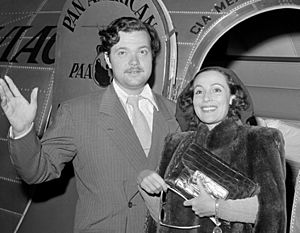
Dolores met actor and filmmaker Orson Welles at a party. They felt a mutual connection and became close. Welles had admired her since he was a teenager. Welles said, "That’s when I fell in love with her." He later added, "She changed my life." Their relationship was kept private until 1941, when Dolores filed for divorce from Cedric Gibbons. They openly appeared together in New York while Welles was directing a play. After her divorce, she became deeply involved in Welles's world, finding his mind brilliant. Welles also praised her, saying, "She lives so graciously. Everyone around her loves her. She is the one girl you can be with and not feel the need for conversation. She has a mind full of talk, though, when she wants." During the filming of Citizen Kane, Dolores was often by Welles's side, helping him through difficult times. They acted together in the movie Journey into Fear (1943).
Their relationship ended after four years. Welles was filming in Rio de Janeiro and news of his behavior reached the United States. Offended, Dolores decided to end their relationship with a telegram that he never answered. He later married Rita Hayworth, who was sometimes called "The New Dolores del Río of Hollywood."
Welles never fully got over her. He would sometimes go to Mexico to try to see her, or send his children, whom she would welcome. Rebecca Welles, the daughter of Welles and Hayworth, wanted to meet Dolores on her 18th birthday. In 1962, Dolores welcomed her at her home in Acapulco. After their meeting, Rebecca said, "My father considered Dolores the great love of his life. She is a living legend in the history of my family." According to Rebecca, Welles felt a kind of obsession for Dolores until the end of his life. For the rest of her life, Dolores kept a card with two beautiful slanted eyes (like her own) and a dove drawing with the word "always" signed "Orson."
Alleged rivalries
There are many stories about her rivalry with Lupe Vélez. Dolores never understood why Vélez was so competitive with her. Vélez disliked Dolores and called her "bird of bad omen." Dolores was afraid to meet her in public. When they did, Vélez was often harsh and aggressive. Vélez openly copied Dolores, making fun of her elegance. But Dolores's reputation was well-known and respected, and Vélez could not ignore this. Vélez wore spectacular costumes but never achieved Dolores's supreme elegance. Vélez was popular and had many friends, but she was not part of the same Hollywood social circles where Dolores was accepted. Vélez spoke badly of Dolores, but Dolores never spoke offensively about her. Vélez clearly felt jealous of Dolores's success during their time in Hollywood.
The media also speculated about a strong rivalry between Dolores del Río and María Félix, another famous Mexican actress. Félix said in her autobiography: "With Dolores I don't have any rivalry. On the contrary. We were friends and we always treated each other with great respect. We were completely different. She [was] refined, interesting, soft on the deal, and I'm more energetic, arrogant and bossy." Félix also said: "Dolores del Río was a great lady. She behaved like a princess. A very intelligent and very funny woman. I appreciate her very much and I have great memories of her."
Death
In 1978, she was diagnosed with osteomyelitis, a bone infection. In 1981, she got hepatitis B from a contaminated vitamin injection. She also suffered from arthritis. In 1982, Dolores was admitted to Scripps Hospital in La Jolla, California, where her hepatitis led to cirrhosis (liver damage).
On April 11, 1983, Dolores del Río passed away from liver failure at age 78 in Newport Beach, California. It is said that on the day she died, an invitation to attend the Oscars was sent to her. She was cremated, and her ashes were moved from the United States to Mexico. They were buried at the Panteón de Dolores in Mexico City, specifically in The Rotunda of Illustrious Persons, a special place for famous people.
Legacy
Dolores del Río was the first Mexican actress to become successful in Hollywood. After her, other Mexican stars followed, including Lupe Vélez, Katy Jurado, and Lupita Tovar. In recent years, other Mexican stars who have made it in Hollywood include Salma Hayek, Eiza González, and Adriana Barraza.
In art and literature
Dolores del Río's physical features made her admired even after her death. From a young age, she was smart enough to surround herself with intellectual people. Her Hollywood fame placed her in a special position, as she became one of the women connected to the rebirth of Mexican culture and traditions.
Dolores's face was also admired by many artists who painted her. In 1916, when she was 11, she was first painted by Alfredo Ramos Martínez, a popular artist among Mexican high society. In the 1920s, Dolores was also painted by Mexican artists Roberto Montenegro and Ángel Zárraga. In 1938, she was painted by her close friend, the famous Mexican artist Diego Rivera. This portrait was made in New York and was Dolores's favorite, holding a special place in her home in Mexico. Rivera also included Dolores in some of his paintings and murals, such as La vendedora de flores and La Creacion. In this last mural, located in the Colegio de San Ildefonso in Mexico City, the actress represents "Justice."

In 1941, Dolores was also painted by the famous Mexican muralist José Clemente Orozco. This portrait was requested by Orson Welles. Unfortunately, when the artist painted it, he was losing his eyesight. Dolores said: "He painted his tragedy on my face!" Although Dolores did not like the portrait, it had a very important place in her home. Other artists who painted her include Miguel Covarrubias, Rosa Rolanda, and Adolfo Best Maugard.
In 1970, several Mexican cultural organizations honored her with a tribute called Dolores del Rio in the Art. This event displayed her main portraits and a sculpture by Francisco Zúñiga.
In her will, Dolores stated that all her artworks should be given to the National Institute of Fine Arts and Literature of Mexico. These works are now displayed in various museums in Mexico City, including the National Museum of Art and the Home-Studio of Diego Rivera and Frida Kahlo.
Dolores was the model for the statue of Evangeline, the heroine of Longfellow's poem. The statue is located in St. Martinville, Louisiana, and was donated by Dolores, who played Evangeline in the 1929 film.
Poet Salvador Novo wrote a sonnet for her and translated all her stage plays. She inspired Jaime Torres Bodet's novel La Estrella de Día (Star of the Day), published in 1933, which tells the story of an actress named "Piedad." Vicente Leñero was inspired by Dolores to write his book, Señora. Carlos Pellicer also wrote her a poem in 1967. In 1982, Dolores and Maria Félix were featured in the novel Orchids in the Moonlight: Mexican Comedy by Carlos Fuentes. Other authors who wrote poems for her include Xavier Villaurrutia and Pita Amor.
After her death, her photo collection was given to the Carso Center for the Study of Mexican History by Lewis Riley.
Memorials
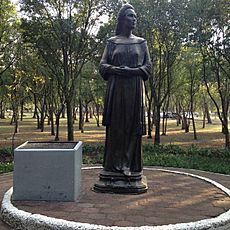
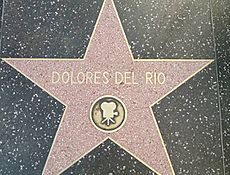
- She has a star on the Hollywood Walk of Fame at 1630 Vine Street for her contributions to the film industry.
- Dolores del Río also has a statue at Hollywood-La Brea Boulevard in Los Angeles. It was designed by Catherine Hardwicke to honor important multi-ethnic leading ladies of cinema, including Mae West, Dorothy Dandridge, and Anna May Wong.
- There is a mural of Dolores del Río painted on the east side of Hudson Avenue, just north of Hollywood Boulevard, by Mexican-American artist Alfredo de Batuc.
- Dolores del Río is one of the entertainers shown in the mural "Portrait of Hollywood," designed in 2002 by artist Eloy Torrez at Hollywood High School.
- Dolores del Río is honored with three monuments in Mexico City. The first is a statue in the second section of Chapultepec Park. The other two are busts: one in Parque Hundido and another at the nursery named after her.
- In Durango, Mexico, her hometown, an avenue is named after her: Blvd. Dolores del Río.
- Since 1983, the Mexican Film Journalists (PECIME) have given the Diosa de Plata (Dolores del Río) Award for the best dramatic female performance.
- In 1995, fashion designer John Galliano created a tribute to Dolores in his Fall/Winter collection called Dolores.
- In 2005, on what was thought to be her 100th birthday (she was actually born in 1904), her remains were moved to the Rotonda de las Personas Ilustres in Mexico City.
- On August 3, 2017, the 113th anniversary of her birth, Google released a Google Doodle honoring Dolores del Río.
- After her death, actor Vincent Price used to sign his autographs as "Dolores del Río". When asked why, he replied: "I promised Dolores on her deathbed that I would not let people forget about her."
Characterizations
- Chester Gould, the creator of Dick Tracy, was inspired by Dolores del Río to create Texie Garcia, one of Tracy's main enemies.
- She appeared in old film footage in the Woody Allen film Zelig (1983).
- She was played by actress Lucy Cohu in the TV film RKO 281 in 1999.
- Dolores del Río is one of the Mexican celebrities honored with a cameo in the Disney-Pixar animated movie Coco in 2017.
- She was played by actress Elsa Ortiz in the streaming series María Félix: La Doña, produced by TelevisaUnivision.
Filmography
Selected films:
- Joanna (1925)
- What Price Glory? (1926)
- Resurrection (1927)
- The Loves of Carmen (1927)
- Ramona (1928)
- Evangeline (1929)
- Bird of Paradise (1932)
- Flying Down to Rio (1933)
- Wonder Bar (1934)
- Madame Du Barry (1934)
- In Caliente (1935)
- Devil's Playground (1937)
- Journey Into Fear (1943)
- Wild Flower (1943)
- María Candelaria (1943)
- Las Abandonadas (1944)
- Bugambilia (1944)
- La Otra (1946)
- The Fugitive (1947)
- The Unloved Woman (1949)
- Doña Perfecta (1951)
- El Niño y la niebla (1953)
- La Cucaracha (1959)
- Flaming Star (1960)
- Cheyenne Autumn (1964)
- More Than a Miracle (1967)
- The Children of Sanchez (1978)
Selected theatre roles:
- Anastacia (1956)
- Lady Windermere's Fan (1958)
- The Road to Rome (1959)
- Ghosts (1962)
- Dear Liar: A Comedy of Letters (1963)
- The Lady of the Camellias (1968)
Images for kids
See also
 In Spanish: Dolores del Río para niños
In Spanish: Dolores del Río para niños


